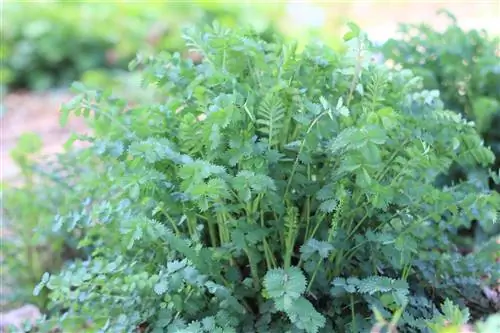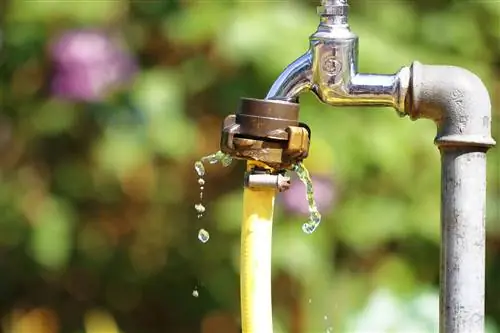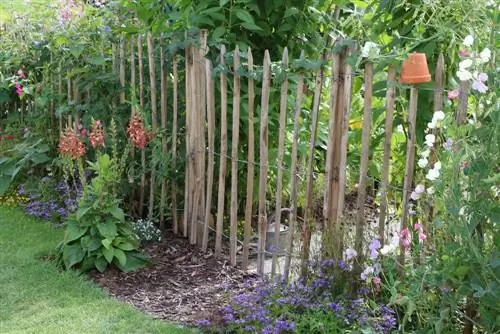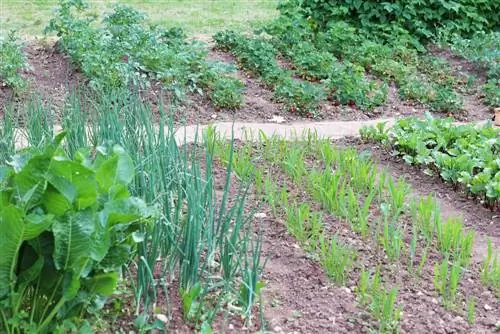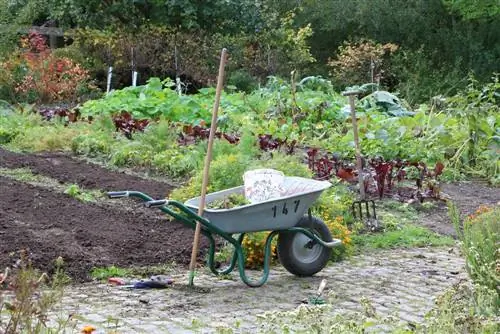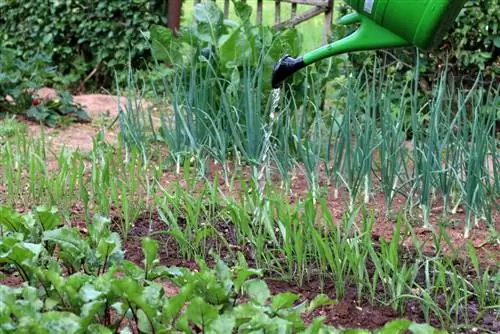- Author admin [email protected].
- Public 2023-12-17 03:39.
- Last modified 2025-01-24 12:45.
The pimpinelle botanically belongs to the rose family or Rosaceae and is very aromatic as a spice plant and has a cool taste that is slightly reminiscent of cucumbers. But that's not all that this plant can offer, because the plant can also be used very well for he alth and, for example, as a tea infusion, can have a detoxifying effect on the organism. The wild plant can also be cultivated in your own garden.
Medical effects
The Pimpinelle has a blood-purifying, anti-inflammatory, expectorant, diuretic effect and, when brewed as a tea, is well suited for heartburn, fatigue, flatulence and diarrhea. The root of the pimpinelle is excellent for coughs and is even used in conventional medicine against asthma. Pimpinelle is also a proven remedy for flu or sore throats in medicine. Pimpinelle root tea has a positive detoxifying effect on the body after long-term medication or exposure to harmful substances. In addition, the Pimpinelle provides a lot of vitamin C, especially in the cold season.
In the kitchen
The leaves of the pimpinelle have a cooling taste and are reminiscent of the taste of cucumbers. The pimpinelle is one of the classic seven herbs that belong in the Frankfurt green sauce. For cooked dishes, the Pimpinelle is only added to the dish after cooking to preserve the fresh aroma. But this plant also tastes very good as a spice in salads, quark and herb butter as well as in fresh soups and vegetables or simply on bread spread with butter. It is also a classic ingredient in Hamburg eel soup and nine-starch soup. The Pimpinelle is also very suitable for preparing herbal vinegar and refreshing summer punch.
Profile
- The pimpinelle is a perennial, so-called perennial, plant that is frost hardy in our region and is therefore ideal for gardening.
- The plant grows to a height of 20 to 40 cm, grows upright and forms clumps.
- The flowering period is from June to July, with the plant producing greenish-brown to reddish-brown flowers.
General information about keeping things in the garden
The Pimpinelle is very undemanding and thrives very well in nutrient-poor, lime-rich and moderately dry locations. If the herb is grown in nutritious and moist soil, the taste of the young herb is very mild and delicate with a hint of cucumber or cucumber peel flavor.
Pimpinelle (Sanguisorba minor) in the herb garden
The Pimpinelle can be released in spring or autumn or bought as a seedling from the nursery. Once the pimpinelle is in the garden, it reproduces independently. The pimpinelle grows as a perennial in the herb garden and the hobby gardener should regularly remove the old plants and make space for the self-sowing young plants, especially since the old leaves of old plants are also inedible. If they are not removed, the old plants will wither on their own. The plant is an annual and only the delicate leaves of the plant are used.
Ideal location
In nature, the pimpinelle grows in dry and sunny meadows and originally comes from the Mediterranean region. However, this dry and sunny location is not optimal if the plant is to be used as an aromatic culinary herb, because then a slightly moist and nutrient-rich, calcareous soil is more useful for the aroma. The Pimpinelle thrives in both partial shade and full sun, but in the latter location it should not dry out in order to preserve its delicate aroma. The Pimpinelle estimates at the location
- moist and nutrient-rich soil
- calcareous substrate
- alkaline soils
Care
The Pimpinelle is undemanding in care. Grows best in sunny to partially shaded locations. The Pimpinelle prefers a calcareous, well-drained and relatively nutrient-rich soil that is moist, but not wet. Normal, permeable soil should be selected as the substrate. The plant particularly appreciates calcareous and alkaline soils. It is important not to let the soil for the pimpinelle dry out and to provide the plant with regular watering. For particularly intensive growth, a humus-rich soil is ideal, as is the incorporation of compost and organic fertilizers such as horn shavings in spring. The inflorescences should be cut regularly because only the leaves can be used in the kitchen. The Pimpinelle
- must never dry out completely
- needs organic fertilizers for good growth
- The inflorescences should be cut regularly
Harvest
The delicate leaves of the Pimpinelle can be harvested continuously until autumn. It is also possible to dry the leaves, but the delicate, special taste then disappears. You can also freeze the leaves or soak them in oil or vinegar. A particularly good aroma can be achieved by placing the leaves in lemon juice. For use in the kitchen, only the fresh, young leaves that are continually being formed are used, because the older leaves become hard and inedible. Within naturopathy and for these purposes, the entire plant is used, including the roots. In this case, the flowering herb is used after drying.
Propagation
Propagation can be done either by sowing seeds or by dividing the plant in spring or autumn. Sowing or planting seedlings should be done immediately at the final selected location, as it is difficult to correct the location of the pimpinelle afterwards because the plant develops long taproots that are damaged if moved.
Diseases and pests
The Pimpinelle is quite robust and rather insusceptible to diseases and pests. Only when the plant is weakened do downy mildew as a fungal disease and aphids have a chance of attacking the plant. An infestation with downy mildew can be recognized by brown spots that spread on the leaves. This infestation can be promoted by constant watering from above, i.e. via the leaves. Downy mildew infestations can be combated using fungicides, but this affects the usability of the leaves in the kitchen. Prevention makes more sense by watering from below and also protecting the plant against excessive rainfall. The aphid can be removed using commercially available, but preferably natural, means so that the pimpinelle can still be used as a culinary herb. The plant can be strengthened against pest infestation and disease through regular fertilization with compost soil.
Diseases of the robust plant can be avoided by:
- Watering the plant from below
- Protection from intense rainfall on the leaves
- Strengthening the plant through regular fertilization with compost soil
Frequently asked questions
How he althy is the Pimpinelle actually?
In the Middle Ages, Pimpinelle was even said to have an effect against the plague. This can be doubted, but the herb is rich in essential oils, bitter substances as well as resins and vitamin C. In the kitchen, the pimpinelle can therefore not only have good taste, but also have many positive properties for digestion and the immune system. In naturopathy, the herb is also very popular for various ailments, and pimpinelle has even found its way into modern conventional medicine as a proven remedy for relieving asthma symptoms. Even if you are prone to spring fatigue, the Pimpinelle is now used equally in conventional medicine and in naturopathy.
Is the pimpinelle a native plant?
The wild pimpinelle has its origins in Asia. But the plant was also known in southeastern, central and western Europe centuries ago. Today, pimpinelle is grown almost exclusively in the Frankfurt area because it is a classic there as an ingredient for green sauce.
What you should know about Pimpinelle in brief
As early as the Middle Ages, the pimpinelle, which was often referred to as the bibernelle at the time, was found in numerous gardens. It was particularly popular as a seasoning plant in Elizabethan England. But the well-known Jacobus Theodorus Tabernaemontanus also already knew about the spicy power of pimpinelle, which is now almost one of the forgotten herbs. The pimpinelle was also used extensively in natural medicine at that time. She should even be able to cure the plague. But the Pimpinelle was also often used for heart diseases and problems with the bladder and kidneys. Due to its high vitamin content and astringent properties, it is also said to have a positive effect on inflammation of the skin.
Usage
- The Pimpinelle can still be used wonderfully in the kitchen today. However, only the very young leaves are suitable for this.
- They are used in egg and curd dishes, but also add the finishing touch to salads, mayonnaise or herb butter.
- So that the Pimpinelle can be used in the kitchen, it should be sown in your own garden.
- It cannot be preserved as a herb and must be processed immediately after picking.
- Ideally, the fresh young leaves are picked steadily. Older and harder leaves should not be used, as they are considered inedible.
For this reason, the inflorescences should be removed immediately, as you only need the fresh leaves for use as a spice.
In naturopathy, the entire, still-flowering herb is used with the root. It is dried for use and can then be used internally as a tea or externally as a tincture.
Cultivation
- The Pimpinelle can be sown in March or April.
- A location outdoors or on a green meadow in your own garden is best suited.
- Due to the long taproot that the pimpinelle forms, the plant can only be moved later with great effort or not at all.
- Therefore, it should be sown directly at its final destination.
- Basically, the plant itself is quite undemanding. However, you should make sure to sow them in a sunny location.
- Dry, lean and sunny meadows are the preferred location of the Pimpinelle, where it even appears wild from time to time.
- The sun is also responsible for the Pimpinelle's particularly intense aroma.
- If the soil is calcareous and rich in humus, the plant thrives particularly well.
Attention:
However, it can quickly develop into a nuisance weed if the inflorescences are not removed in time. Because then the Pimpinelle self-sowing begins. Depending on the soil conditions, the plant grows to different sizes. For example, a very thin layer of soil usually only produces very small plants. However, if the soil layer is quite thick, the pimpinelle can reach a height of up to one meter.

